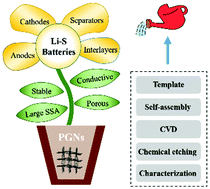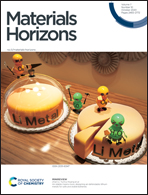Status and prospects of porous graphene networks for lithium–sulfur batteries
Abstract
Lithium–sulfur (Li–S) batteries are one of the most promising next generation battery systems owing to their high energy density and low cost, but they suffer from the low conductivity of sulfur, polysulfide shuttling and lithium dendrite growth, which limit their practical applications. Porous graphene networks (PGNs) not only have the advantages of graphene as a multifunctional host, but also exhibit unique properties derived from their porous structures, which enable PGNs to have a variety of positive effects in Li–S batteries. Here, we provide an overview of the roles and functions of PGNs in Li–S batteries, including increasing sulfur utilization, confining sulfur species, accommodating the volume change of sulfur, improving the conversion kinetics of polysulfides, reducing the consumption of lithium, preventing the dendrite growth, and acting as flexible hosts. The systematic summary of the recent progress in the use of PGNs in different components of Li–S batteries provides guidance for designing materials with diversity that meet different requirements. By mechanism analysis and a recent achievement summary of PGNs in Li–S batteries, we hope to inspire further developments of PGNs in Li–S batteries one step closer to industrialization.



 Please wait while we load your content...
Please wait while we load your content...